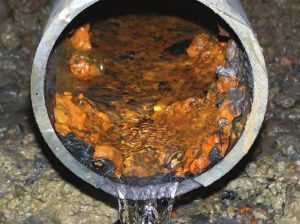“Primum non-Nocere”—above all, do no harm. As physicians and public health professionals, this is our primary goal, to protect communities and individuals from disease and injury. But even our best intentions to help improve general safety can have unintended, detrimental consequences.
Improving drinking water quality is an objective of public health officials all around the world. Although water treatment processes may improve, aging water infrastructure can severely impact quality by the time it gets to the tap. The majority of distribution pipes in developed countries, including the United States, have or will reach the end of their lifespan within the next 20 years. Congress banned the use of lead pipes for new construction in 1986, yet between 3.3-10 million of older water pipes are still lead-based. This poses a significant public health risk because older water main pipes are also more vulnerable to accumulate contaminants, biofilm, and loose deposits. Why replace pipes? According to a 2016 New York Times Article, the estimated cost to replace these pipes will be between $16.5- $50 billion (about $5,000 per pipe). However, the EPA says the deferred maintenance costs for the existing aging pipes would be $384 billion by 2030 to keep drinking water potable. In response, many cities are replacing them with newer, safer pipes.
While the ultimate goal of replacing lead pipes will reduce lead contaminants in the water, the removal and replacement of the pipes, if not well-planned, carries a significant risk to the public. With the removal and replacement of lead pipes, the sludge and biofilm that line the interior of the old pipes can become dislodged and flow downstream into community water systems (healthcare facilities, schools, daycares, homes etc.). Vulnerable populations can be exposed to Legionella, other deadly water borne pathogens, and heavy metals such as lead as a result. Legionella is a deadly bacteria often found in biofilm that can cause Legionnaires’ disease.
In addition to Legionella, a multitude of other bacteria, fungi, and viruses can be found in biofilm. Such as:
- Pseudomonas
- Klebsiella
- Mycobacterium
- Escherichia coli (O157:H7)
- Acinetobacter spp.
- Burkholdaria cepacia
- Enterobacter
- Stenotrophomonas maltophilia
- Norovirus
- Aspergillus spp.
If utilities departments, healthcare officials and construction managers are not proactive, all of these unwanted contaminants can flow into community water systems, causing outbreak and catastrophe. Capture systems should divert or capture the contaminated water to prevent waterborne pathogens, biofilm, and heavy metal sediments becoming dislodged—causing more harm than good. Thinking of not only primary, but secondary and tertiary effects of public health interventions can help prevent inadvertent injuries to the public.
For more information about Legionella, or waterborne pathogens, or water infrastructure, contact the experts at Cogency: solutions@cogencyteam.com

